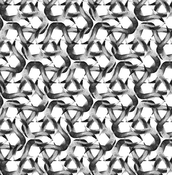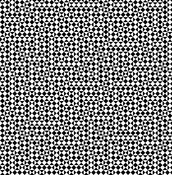Information
- Publication Type: Master Thesis
- Workgroup(s)/Project(s):
- Date: June 2013
- Date (Start): 2013
- Date (End): 2013
- TU Wien Library:
- First Supervisor: Eduard Gröller
Abstract
An approach called Inductive Rotation (IR), developed by artist Hofstetter Kurt, can be used to create intricate patterns that fill the 2D plane from a single prototile by repeated translation and rotation. These patterns are seemingly nonperiodic and have interesting features, both from a mathematical and artistic viewpoint.The IR method has not yet been described in scientific literature. It is related to and has been inspired by aperiodic tilings like the well-known Penrose tilings.
During the course of this thesis some research on the patterns generated by Inductive Rotation has been done and algorithms that allow for automatic generation of these patterns have been developed. The implementation is then called the Irrational Image Generator, a tool that on the one hand is a reference implementation of the IR method,and on the other hand can be used by the artist for further experimentation to fully utilize the artistic possibilities of the IR approach.
The Irrational Image Generator is preceded by a series of prototypes, that have been developed to get a better grasp of the expected results and performance of the tool.
Each prototype as well as the final implementation were tested by Hofstetter Kurt. This iterative development process has led to two different implementation approaches that both have their advantages and disadvantages. For this reason, both methods have been considered in the final implementation.
Generation algorithms that operate on geometry instead of directly manipulating bitmap data have been developed. The program makes use of the GPU through OpenGL to render the resulting patterns through textured polygons.
It turns out that run-time and memory usage of the IR algorithm grow exponentially with the number of iterations. This means that iteration numbers are limited, although the tool’s performance is sufficient for artistic purposes.
Additional Files and Images
Weblinks
No further information available.BibTeX
@mastersthesis{Parzer_2013_IIG,
title = "Irrational Image Generator",
author = "Simon Parzer",
year = "2013",
abstract = "An approach called Inductive Rotation (IR), developed by
artist Hofstetter Kurt, can be used to create intricate
patterns that fill the 2D plane from a single prototile by
repeated translation and rotation. These patterns are
seemingly nonperiodic and have interesting features, both
from a mathematical and artistic viewpoint. The IR method
has not yet been described in scientific literature. It is
related to and has been inspired by aperiodic tilings like
the well-known Penrose tilings. During the course of this
thesis some research on the patterns generated by Inductive
Rotation has been done and algorithms that allow for
automatic generation of these patterns have been developed.
The implementation is then called the Irrational Image
Generator, a tool that on the one hand is a reference
implementation of the IR method,and on the other hand can be
used by the artist for further experimentation to fully
utilize the artistic possibilities of the IR approach. The
Irrational Image Generator is preceded by a series of
prototypes, that have been developed to get a better grasp
of the expected results and performance of the tool. Each
prototype as well as the final implementation were tested by
Hofstetter Kurt. This iterative development process has led
to two different implementation approaches that both have
their advantages and disadvantages. For this reason, both
methods have been considered in the final implementation.
Generation algorithms that operate on geometry instead of
directly manipulating bitmap data have been developed. The
program makes use of the GPU through OpenGL to render the
resulting patterns through textured polygons. It turns out
that run-time and memory usage of the IR algorithm grow
exponentially with the number of iterations. This means that
iteration numbers are limited, although the tool’s
performance is sufficient for artistic purposes.",
month = jun,
address = "Favoritenstrasse 9-11/E193-02, A-1040 Vienna, Austria",
school = "Institute of Computer Graphics and Algorithms, Vienna
University of Technology ",
URL = "https://www.cg.tuwien.ac.at/research/publications/2013/Parzer_2013_IIG/",
}
 Poster
Poster Thesis
Thesis



